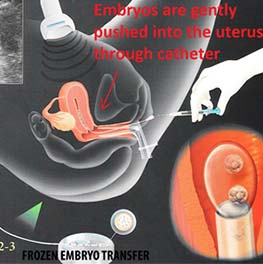Service Brief and Information:
The treatment to establish a pregnancy using frozen embryos has been called a frozen embryo transfer cycle or simply an FET cycle.
The number of embryos recommended for transfer will be made in consultation with your physician. Most commonly it is one and sometimes two or three. Some factors that influence their recommendation include: the age of the person from whom the eggs came, the pre-freezing embryo quality assessment. The “Consent to Thaw & Transfer Frozen Embryos” must be signed by each partner (where applicable) prior to the thawing process.
The timing of the embryo transfer depends on a number of factors including the cell stage of the embryo(s) when frozen and uterine lining thickness.
In most cases, you will be prescribed natural hormones to duplicate the changes that occur in your uterus during a regular menstrual cycle, before a frozen embryo transfer is performed. This requires the use of the two natural hormone medications: estrogen and progesterone.
During a natural menstrual cycle, estrogen is produced by the developing follicle. This estrogen acts on the uterus to thicken and mature the uterine lining. Estrogen is given in a FET cycle for the same purpose. After 12 or more days on estrogen you will come to the clinic for a transvaginal ultrasound to determine your uterine lining thickness and pattern and a blood test will be taken to measure the level of estrogen in your blood. On occasion, if the lining is not thickening as it should, the dose or type of estrogen may be increased or prolonged, other medications may be recommended, or the cycle will be cancelled and restarted.
Once the uterine lining has developed sufficiently, progesterone is added. Progesterone matures the uterine lining and makes it receptive for an embryo to implant. Once progesterone is begun, there is a certain “window of implantation” during which the embryo(s) must be transferred.
It is possible that one or more embryos will not survive the thaw. In this case additional embryo(s), if available, will be thawed to obtain the number of embryos desired for transfer. It is only possible to determine which embryos will survive after they have been thawed. Patients will be informed of the thaw results by their physician just prior to the transfer procedure.
You will be asked to do a blood pregnancy test two weeks after the embryos are transferred.
Based on studies that have been performed in humans, the risk of birth defects in babies that develop from frozen embryos is no higher than in maternal age-matched naturally conceived pregnancies. The risk of birth defects in babies that develop from frozen embryos is determined by the age of the woman from whom the eggs were obtained on the date those eggs were harvested, not her age at the time the embryos are transferred.





